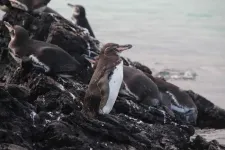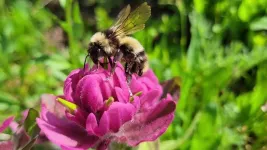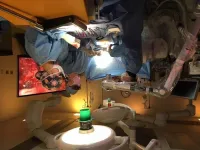(Press-News.org) Microplastics, with a size from 1 micron to < 5 millimeters, are pervasive pollutants that have been found in all parts of the global ocean, and have made their way into the marine food webs. Researchers, led by University of British Columbia UBC’s Institute for the Oceans and Fisheries scientists and Ecuadorian researchers from Galápagos and the ESPOL Polytechnic School (Guayaquil, Ecuador), looked closely at how microplastic bioaccumulation was affecting the endangered Galápagos penguin (Spheniscus mendiculus) as an indicator species to trace how deeply microplastic bioaccumulation has entered the food web in the isolated Galápagos Islands.
An analysis of seawater collected around Santa Cruz Island, a human-populated island, with nearby Galápagos penguin colonies revealed plastic particles. Using models that focused on the Galápagos penguin diet (barracuda, sardine, herring, salema, and anchovy), and on penguin scat, researchers intuited a unique Galapagos penguin food web model using Ecopath and Ecosim (EwE) ecosystem modeling with the Ecotracer approach to track the bioaccumulation potential of microplastics in the penguins’ foodweb. They also applied a wider model for Bolivar Channel Ecosystem (between Fernandina and Isabela islands) and part of the penguin’s habitats, located at the western regions of the Galápagos Islands.
The model predictions showed a rapid increase in microplastic accumulation and contamination across the penguins’ prey organisms resulting in Galápagos penguin showing the highest level of microplastics per biomass, followed by barracuda, anchovy, sardine, herring, and salema and predatory zooplankton.
“The model predictions highlight the accumulation behavior and residence time of microplastics in the gut,” said Karly McMullen, first author and a former MSc student at the Institute for the Oceans and Fisheries at the University of British Columbia. “With microplastics emerging as a prominent ocean pollutant, entering the environment every day, there is a growing concern for marine fauna and coastal wildlife, particularly if this anthropogenic threat is reaching even the most remote and protected areas such as the Galápagos Archipelago.”
Senior autho, honorary research associate, and Principal Investigator of the Ocean Pollution Research Unit at Institute for the Oceans and Fisheries at the University of British Columbia, Dr. Juan Jose Alava, agreed. "The goal of this food web bioaccumulation modeling work was to provide science and data to support risk management of hazardous plastic waste, reduce microplastic emissions in the oceans and marine remote UNESCO Heritage sites such as the Galapagos Islands, and inform local and international marine policy to conserve endangered, endemic seabird species of Galapagos Marine Reserve."
“It is imperative that we prioritizing efforts to reduce the input of microplastics into vulnerable ecosystems and food webs, particularly such as that of the endangered Galapagos penguin.”
“Modelling microplastic bioaccumulation and biomagnification potential in the Galápagos penguin ecosystem using Ecopath and Ecosim (EwE) with Ecotracer”, was published in PLOS ONE.
END
Microplastics may be accumulating rapidly in endangered Galápagos penguins’ food web
2024-01-24
ELSE PRESS RELEASES FROM THIS DATE:
The more the merrier: Research shows online interventions with social support help middle-aged adults with obesity lose weight
2024-01-24
Obesity is a problem in the United States. In fact, 42.5% of U.S. adults aged 20 and over have the disease. Not only is obesity the nation’s second leading cause of preventable death (behind only smoking cigarettes), it also leads to other serious health issues, including an increased risk of type 2 diabetes, high blood pressure, heart disease, stroke, cancer, sleep apnea and liver disease. The disease and its side effects impose a significant financial burden on America’s health care system.
As many make — and often fail to keep — New Year’s resolutions about exercise and weight loss goals, University ...
Salk Institute Professor Ronald Evans honored with Japan Prize
2024-01-24
LA JOLLA (January 22, 2024)—Salk Professor Ronald Evans has been named the 2024 recipient of the Japan Prize in the field of Medical Science and Pharmaceutical Science. The Japan Prize Foundation awards this prestigious international award annually to “express Japan’s gratitude to international society.”
"I am delighted to extend my congratulations to Ron for this well-deserved recognition in honor of his discovery of nuclear hormone receptors,” says Salk President Gerald Joyce. “This accomplishment not only reflects the exceptional caliber of Ron’s research ...
How does HIV get into the cell’s centre to kickstart infection?
2024-01-24
UNSW medical researcher Dr David Jacques and his team have discovered how the human immunodeficiency virus (HIV) breaches the cell nucleus to establish infection, a finding that has implications beyond HIV biology.
To infect cells, HIV must enter the target cell and make its way to the nucleus in the cell’s centre where enough copies of its genetic code can be produced to infect other cells.
To safely complete this quest, the virus builds a protective protein coat – a capsid – to shield itself from the host’s immune defences geared to destroy it. Until ...
One in five Colorado bumblebees are endangered, new report says
2024-01-24
On a cliffside at Mesa Verde National Park in southern Colorado, a fuzzy bee was industriously gnawing at the red sandstone. Making a loud grinding sound, the insect used its powerful jaws to drill tunnels and holes in rocks, where it would build a nest for raising offspring.
The bee, known as Anthophora pueblo, is a type of digger bee native to Colorado. Discovered less than a decade ago, the bee has quickly become Adrian Carper’s favorite pollinator.
“This is just one example of how crazily diverse our native bees are,” said Carper, an ...
Mayo Clinic study explores heart failure, uncovers gene’s role in recovery
2024-01-24
Mayo Clinic researchers studying the genetics of people who had recently developed dilated cardiomyopathy, one of the most common causes of heart failure, have found a particular gene to target for developing future drug therapy treatments. The disease makes it harder for the heart's left ventricle to pump blood effectively to the rest of the body. In this first genome-wide association study, the researchers sought to understand why some patients get better after developing the condition — and some don't.
"We found genetic variation in the CDCP1 gene, a gene that no one has heard of in ...
How studying defensive bacteria may help human gut health
2024-01-24
MSU has a satellite uplink/LTN TV studio and Comrex line for radio interviews upon request.
Images
EAST LANSING, Mich. – Thousands of types of bacteria live in the human gut. They help digest the food we eat and absorb nutrients, but these bacteria don’t just do this to be kind to humans, there is a benefit for them too.
Elizabeth Heath-Heckman, an assistant professor in the College of Natural Science, has received a five-year National Institutes of Health grant from the National Institute for General Medical Sciences totaling $1.9 million to support her research studying ...
Study: This protein may be the ‘glue’ that helps COVID virus stick
2024-01-24
When SARS-CoV-2 enters the human body, the virus’ spike protein binds to a cell, allowing the virus to infiltrate and begin replicating.
A new study from Tulane University, conducted in partnership with Florida International University and published in Protein Science, has identified a protein that may be the glue that helps COVID’s spike protein stick.
The study found that a small piece of a proteoglycan called perlecan LG3 – a protein most commonly found in blood vessels and the brain – ...
Can we predict when a migraine attack will occur?
2024-01-24
EMBARGOED FOR RELEASE UNTIL 4 P.M. ET, WEDNESDAY, JANUARY 24, 2024
MINNEAPOLIS – Migraine is often underdiagnosed and untreated, and even when it is treated, it can be difficult to treat early enough as well as find strategies to prevent attacks. A new study looks at ways to more accurately predict when a migraine will occur—through the use of mobile apps to track sleep, energy, emotions and stress—to enhance the ability to prevent attacks. The study is published in the January 24, 2024, online issue of Neurology®, the medical journal of ...
Researchers suggest changing gold standard of spine surgery from operative microscope to 3D exoscope
2024-01-24
While surgeons have more commonly used the exoscope in various intracranial procedures, its use in spinal surgery has been underreported.
Researchers and neurosurgeons at the Medical University of South Carolina (MUSC) retrospectively compared the operative microscope to the 3D exoscope in a recent study published in World Neurosurgery and found better outcomes among both surgeons and patients when using the exoscope.
Stephen Kalhorn, M.D., FAANS, was the principal investigator on the study, and he says the traditional operative microscope has ...
ORNL wins five Federal Laboratory Consortium awards
2024-01-24
Researchers, staff members and licensees from the Department of Energy’s Oak Ridge National Laboratory received top honors in the Federal Laboratory Consortium’s annual awards competition for excellence in technology transfer, excellence in technology transfer innovation, outstanding researcher and regional technology transfer.
The Federal Laboratory Consortium, or FLC, recently announced 32 award winners, ORNL included, for contributions to technology transfer, which turns cutting-edge research into impactful products and services. The FLC represents more than 300 federal laboratories, agencies and research centers ...






